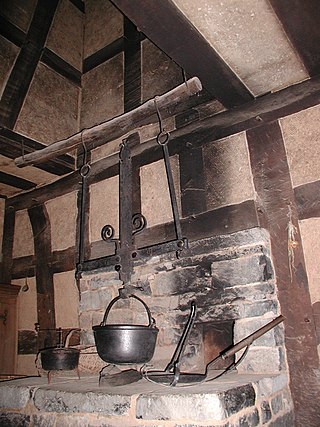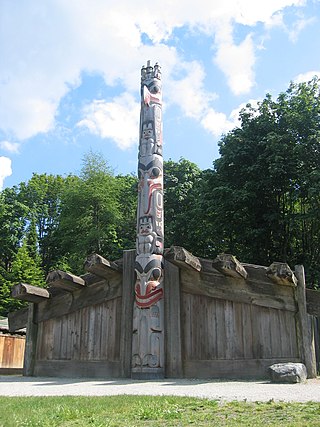
A hearth is the place in a home where a fire is or was traditionally kept for home heating and for cooking, usually constituted by at least a horizontal hearthstone and often enclosed to varying degrees by any combination of reredos, fireplace, oven, smoke hood, or chimney. Hearths are usually composed of masonry such as brick or stone. For centuries, the hearth was such an integral part of a home, usually its central and most important feature, that the concept has been generalized to refer to a homeplace or household, as in the terms "hearth and home" and "keep the home fires burning". In the modern era, since the advent of central heating, hearths are usually less central to most people's daily life because the heating of the home is instead done by a furnace or a heating stove, and cooking is instead done with a kitchen stove/range alongside other home appliances; thus many homes built in the 20th and 21st centuries do not have hearths. Nonetheless, many homes still have hearths, which still help serve the purposes of warmth, cooking, and comfort.

Jarlshof is the best-known prehistoric archaeological site in Shetland, Scotland. It lies in Sumburgh, Mainland, Shetland and has been described as "one of the most remarkable archaeological sites ever excavated in the British Isles". It contains remains dating from 2500 BC up to the 17th century AD.

A longhouse or long house is a type of long, proportionately narrow, single-room building for communal dwelling. It has been built in various parts of the world including Asia, Europe, and North America.

A dugout or dug-out, also known as a pit-house or earth lodge, is a shelter for humans or domesticated animals and livestock based on a hole or depression dug into the ground. Dugouts can be fully recessed into the earth, with a flat roof covered by ground, or dug into a hillside. They can also be semi-recessed, with a constructed wood or sod roof standing out. These structures are one of the most ancient types of human housing known to archaeologists, and the same methods have evolved into modern "earth shelter" technology.

A great hall is the main room of a royal palace, castle or a large manor house or hall house in the Middle Ages, and continued to be built in the country houses of the 16th and early 17th centuries, although by then the family used the great chamber for eating and relaxing. At that time the word "great" simply meant big and had not acquired its modern connotations of excellence. In the medieval period, the room would simply have been referred to as the "hall" unless the building also had a secondary hall, but the term "great hall" has been predominant for surviving rooms of this type for several centuries, to distinguish them from the different type of hall found in post-medieval houses. Great halls were found especially in France, England and Scotland, but similar rooms were also found in some other European countries.

Fulacht fiadh is the name given to one of many burned mounds, dating from the Bronze Age, found in Ireland. Most surviving examples consist of a low horseshoe-shaped mound of charcoal-enriched soil, and heat shattered stone, with a cooking pit located in a slight depression at its centre. In ploughed fields, they are apparent as black spreads of earth interspersed with small sharp stones.

The Weeden Island cultures are a group of related archaeological cultures that existed during the Late Woodland period of the North American Southeast. The name for this group of cultures was derived from the Weedon Island site in Old Tampa Bay in Pinellas County.

The Mumun pottery period is an archaeological era in Korean prehistory that dates to approximately 1500-300 BC. This period is named after the Korean name for undecorated or plain cooking and storage vessels that form a large part of the pottery assemblage over the entire length of the period, but especially 850-550 BC.

Horr's Island is a significant Archaic period archaeological site located on an island in Southwest Florida formerly known as Horr's Island. Horr's Island is on the south side of Marco Island in Collier County, Florida. The site includes four mounds and a shell ring. It has one of the oldest known mound burials in the eastern United States, dating to about 3400 radiocarbon years Before Present (BP). One of the mounds has been dated to as early as 6700 BP. It was the largest known community in the southeastern United States to have been permanently occupied during the Archaic period.

Aşıklı Höyük is a settlement mound located nearly 1 kilometre (0.62 mi) south of Kızılkaya village on the bank of the Melendiz brook, and 25 km (16 mi) southeast of Aksaray, Turkey. Aşıklı Höyük is located in an area covered by the volcanic tuff of central Cappadocia, in Aksaray Province. The archaeological site of Aşıklı Höyük was first settled in the Pre-Pottery Neolithic period, around 8,200 BC.

The Upper Mississippian cultures were located in the Upper Mississippi basin and Great Lakes region of the American Midwest. They were in existence from approximately A.D. 1000 until the Protohistoric and early Historic periods.
The Sixtoe Mound site (9MU100) is an archaeological site in Murray County, Georgia excavated by Arthur Randolph Kelly from 1962-1965 as a part of the Carters Dam project conducted for the National Park Service by the University of Georgia. The site consisted of a low platform mound and an associated village. The majority of the mound was excavated, while the village received little excavation.
The Mill Branch archaeological site is located in Warren County, Georgia west of Augusta and south of Thomson. It is located in the Brier Creek watershed. A reservoir was deemed necessary to assist in kaolin processing during times of drought. For this project to commence, a permit was needed from the Corps of Engineers, which required a cultural resource impact study to first be done. J.M. Huber Corporation contracted Southeastern Archaeological Services to do an initial survey of the area in 1988 with additional data recovery in 1990. J.M Huber Corporation determined that two sites surveyed by Southeastern Archaeological Services, specifically 9WR4 and 9WR11, could not be avoided or preserved. Huber no longer owns this property. These two sites were excavated between April 23 and May 31, 1990. The field report, Archaeological Investigations at Mill Branch Sites 9WR4 and 9WR11 Warren County, Georgia, was published in 1995 and compiled by R. Jerald Ledbetter.

West Stow Anglo-Saxon Village is an archaeological site and an open-air museum located near to West Stow in Suffolk, eastern England. Evidence for intermittent human habitation at the site stretches from the Mesolithic through the Neolithic, Bronze Age, Iron Age and Romano-British period, but it is best known for the small village that existed on the site between the mid-5th century and the early 7th century CE, during the early Anglo-Saxon period. During this time, around 70 sunken-featured buildings were constructed on the site, along with 8 halls and a number of other features. Subsequently, abandoned, the area became farmland in the Late Medieval period.

The Ellerbusch site (12-W-56) is a small but significant archaeological site in the southwestern part of the U.S. state of Indiana. Unlike many sites created by people of the same culture, it occupies an upland site near a major river floodplain. Its existence appears to have been the result of the coincidence of periods of peace and growth in the related Angel site, which led some townspeople to leave their homes for new villages that were more convenient for resource gathering. Researched partly because of its small size, Ellerbusch has produced information that greatly increases present awareness of other small sites and of its culture's overall patterns of settlement in the region. Because of its archaeological value, the site was declared a historic site in the late twentieth century.
Keatley Creek is a significant archaeological site in the interior of British Columbia and in the traditional territory of the St'at'imc peoples. Its location is in the Glen Fraser area of the Fraser Canyon ranchlands about 18 miles from the town of Lillooet on a benchland flanking Keatley Creek, whose name derives from a former ranch owner, and from which the site takes its name.

Creevykeel Court Tomb is one of the finest examples of a court tomb remaining in Ireland. The monument is located in the N15 Donegal to Sligo road, 50 meters north of Creevykeel cross-roads close to Cliffoney village in County Sligo. The original name for the Creevykeel monument is Caiseal an Bhaoisgin, the Fort of Bhaoisgin, Tobar an Bhaoisgin being the name of the well near the cairn. A second megalithic monument existed 300 meters to the north, but it was demolished around 1890.
Melkhoutboom Cave is an archaeological site dating to the Later Stone Age, located in the Zuurberg Mountains, Cape Folded Mountain Belt, Sarah Baartman District Municipality in the Eastern Cape Province of South Africa.
The Donaldson site is an archaeological site in Ontario that was designated a National Historic Site of Canada in 1982. The 3-acre (12,000 m2) site is the largest within the Saugeen complex, and is representative of typical habitation and mortuary practices of the Woodland period before the European discovery of the Americas, from about 200 BCE until 700 CE.
The Mouse Creek phase is an archaeological culture of the Eastern Tennessee region of Mississippian chiefdoms, first defined by T. M. N. Lewis and Madeline Kneberg in their examinations of the Chickamauga Basin. This area exhibits artifacts, burials, and architecture distinct from other settlements in the area. The region was occupied from around 1400–1600.













